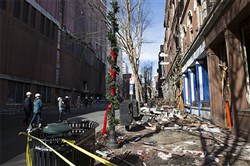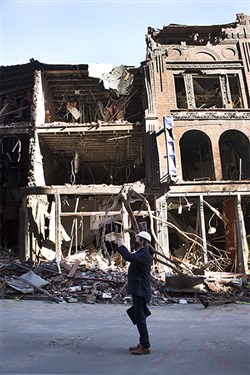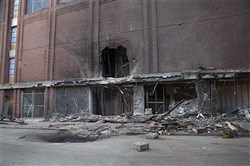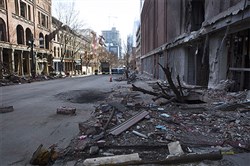VOL. 45 | NO. 4 | Friday, January 22, 2021
Nashville history not easily recreated
By Hollie Deese
After Tim Walker realized no one was killed in the Christmas morning suicide bombing on Second Avenue, his mind turned to the history the city might have lost, a history he has worked decades to preserve amid the cranes and congestion that seem to dominate Downtown Nashville.
“That whole street is so important because it’s part of the original city layout,” says Walker, executive director of the Metro Historical Commission. “Those buildings, a couple of them, were built pre-Civil War in 1860. Most of the rest, although some are early 20th century, the majority of the buildings really date to the 1870s to 1890.
“Some were built when steamboats were still a major form of moving goods into and out of cities. So they represent our city’s early development and history.”
The Second Avenue Commercial District, listed on the National Register of Historic Places since 1972, consists of Second Avenue North between Brandon and Broadway. Buildings are noted for their Victorian Italianate style, brickwork, masonry and cornice work.
“This was Nashville’s front door in the 19th century, and when people and goods came to the city of Nashville by boat on the Cumberland River, these buildings were the first thing they saw,” says historian and ninth generation Nashvillian David Ewing.
Second Avenue is also the deepest block downtown - there is no alley that runs between First and Second, so the buildings are about 200 feet deep and run street face to street face.
The lower levels were used to load or unload goods directly to and from boats moored on the banks of the Cumberland River. Goods arriving by boat would be sold on Market Street or transported to other locations.
“They are there as witnesses,” Walker says of the buildings. “They bear witness to that early history. And it’s dear to my heart because it’s where this office, our commission, was created in 1966.
“And it’s where so much effort was spent in our early years in the late 60s and especially in the 70s and early 80s, trying to promote people going back downtown when it was dead at that time.”
Now Walker can be a witness for the buildings that were damaged or destroyed in the bombing as he helps ensure they are restored in a way that honors their Victorian architecture, their history downtown and their place in shaping Nashville from the very beginning.
“Nashville, as a growing city, needed these buildings to store the goods that were brought here by ship before they went to market,” Ewing explains. “And so these 19th century warehouses have been a key part of the city for almost 150 years.
“Second Avenue has had its ups and downs over the years based on the growth, and the shifts out of downtown and then back into downtown. But after the Civil War, there was a thriving business district there with a lot of hardware stores and other home improvement entities.”
Protected by historic overlay
Ann Roberts spent three decades with the Metro Nashville Historical Commission and is well-known for her work with historic preservation in the city.

Tim Walker, executive director of the Metro Historical Commission, surveys the damage done on Second Avenue N. with Patrick McIntyre and Commission staff.
-- Photo By Michelle Morrow |The Ledger“What makes them special is the materials, the architectural detail, the fact that they blend together so well, the use of stone with the cast-iron storefronts and the fact that there was this long row of them really speaks to our beginnings as a city on a river,’’ she says.
“They are outstanding examples of 19th century architecture, and it’s a case of the whole being more significant than the individual parts.”
Roberts moved to Nashville in 1970 and began working at the historical commission in 1976 after meeting the director at the time, May Dean Eberling. Roberts was there for 33 years, eventually as executive director herself from 2002 until she retired in 2008.
“I felt that what we did mattered because we worked so much, not just with the landmarks like the Ryman and Union Station, but so much of it was about neighborhoods, and I loved that part of it,” she says.
Roberts was on her way to open Christmas gifts at her daughter’s house when the explosion happened. She spent much of the remainder of the day watching the drama unfold through local media.
“It certainly didn’t feel real, all that day,” she recalls. “I was terribly, terribly sad and angry that it happened. I had all of those feelings, that somebody could just go down there and do all that damage.”

Tim Walker, executive director of the Metro Historical Commission, documents the carnage.
-- Photo By Michelle Morrow |The LedgerThe National Historic Preservation Act was passed in 1966 after people realized the federal government was doing a great deal of damage to historic and natural resources through the building of the interstate system.
“No one person or no one group is responsible for the preservation of a resource like Second Avenue,” Roberts says. “It has taken so many people who have been courageous. There was a woman named Alison Zimmerman who bought a building on the West side of the street, the tallest building over there, and put in an art gallery years and years ago, and people had offices upstairs.
“I’m pretty sure Bill Purcell had his law office in that building. Tim and Gary Hawkins started Hawkins Partners on Second Avenue. There were so many people who saw the potential.”
Even the historical commission moved their offices to the corner of Second and Broadway in 1978.
“At the time it was considered really an unsafe area,” Roberts remembers. “We had to promise the (Metro) Council that we would not ever have just one person in the building. And we had to walk to our cars together. So it was a time that was really a time of transition.”

Ground zero of the Christmas Day suicide bombing in which Anthony Quinn Warner detonated an RV full of explosives in front of the AT&T switching center on the west side of Second Avenue N.
-- Photo By Michelle Morrow |The LedgerNot that they could have imagined a bombing then, it was the idea that this part of Nashville needed to be preserved that prompted Walker, Roberts and others on the Metropolitan Historic Zoning Commission to push for a historic overlay of Second Avenue N. It was established in March 1997, ensuring exterior alterations, like the rebuilding of facades, in the overlay district require approval from the MHZC.
“The only positive note of it happening here is the historic overlay in place,” Walker says. “Our office is going to review the exteriors and make sure things go back the way they were. And if something was totally lost, you’re not required to go back, but it has to complement the character, the size, the massing of the historic buildings on the street.
“If this had happened in the Fifth Avenue Historic District in front of the Arcade, we wouldn’t have that role, and people could literally put back whatever they wanted.”
If not for the historic overlay on Second Avenue, a property owner could build a tall, modern building that wouldn’t fit the character of the other 19th century buildings on the streets.
“We’ve lost a lot of buildings over the years because of that,” Ewing points out. “The area of Fifth Avenue and Fourth Avenue between Union and Church streets still has some substantial buildings that were originally there, and also the Arcade.

The crater left behind on Second Avenue N. by the explosion of the explosive-laden RV on Christmas morning.
-- Photo By Michelle Morrow |The Ledger“If you’re going to have expanded overlays, it’s a property rights issue,’’ he continues. “The 12th District councilperson has got to propose it, and they haven’t been able to build consensus over the years for things like that, which is why the Second Avenue one was so important when it was passed.
“And then lower Broadway later – if that hadn’t passed when it did, we would have probably have lost a lot of those buildings and you would be looking at modern glass structures and new developments.”
A long rebuild
After the structural assessments of the buildings are complete, those recommendations will be passed to local or national engineering and architectural firms. Architectural drawings will be made, and guidelines will have to be followed in terms of compatibility with materials, window patterns, height and more.
“The mayor has emphasized he’s setting up the rebuild process as an opportunity to better connect downtown to the riverfront across the river and just to the city in general,” says Andrea Fanta in the mayor’s office. “He’s been pretty firm on saying this rebuild process has to be transparent and inclusive.
“So we’re going to tap experts, and we still want to hear from residents who love and care about downtown. So residents and property owners, and Nashvillians, need to be informed and involved every step of the way.”
Insurance also will have to be dealt with.
Federal authorities determined it was not terrorism, which helps. Most insurance companies have, for the most part, stopped covering terrorism-related damage since 9/11.

Tim Walker, executive director of the Metro Historical Commission and Metro Historic Zoning Commission, calls attention to particular bomb damage on Second Avenue N.
-- Photo By Michelle Morrow |The LedgerGov. Bill Lee announced Jan. 5 that the Federal Emergency Management Agency will provide direct assistance to Metro Nashville-Davidson County under the federal Public Assistance program for the emergency response to the bombing.
The emergency declaration authorizes FEMA, under the Robert T. Stafford Act, to provide Metro Nashville-Davidson County government with direct assistance for emergency protective measures, limited to direct federal assistance.
“I’m sure we’ve got some difficult weeks and months ahead with just getting to the point of getting the review done, and with approvals and construction,” Roberts says. “The staff at the historical commission and at the historic zoning commission will be doing all that they can to relieve the stress, be as helpful as possible and facilitate the process.”
This is also an opportunity to repair what’s underneath, like some of the original clay pipes from 1903 and other aging infrastructure.
Materials will need to match those used when the buildings were built. The Rhea Building, for example, is missing brick from the upper left side of the cornice.
Walker says they will be able to find replacements, whether it is old or new with the look of what was there, after the rubble was sifted through in search of anything salvageable to be re-used.
“Metro Public Works has met with representatives from the Historic Commission three times, and our assistant director of operations has toured the site with them, as well to ensure we retain any materials that can be salvaged,” adds Cortnye Stone, communications and community engagement, Metro Nashville Public Works. “Our cleanup has consisted of glass and other unsalvageable debris in the right of way so far.”
After his walkthroughs, Walker says nothing visible could be salvaged. And luckily there is great documentation to turn to during rehabilitation.
“We have asked for assistance from the Tennessee Historical Commission and Metro archives at the public library, to make sure at our office we have a resource of all documentation that exists at the city and state level for that street,” he says.
Metro Codes also is working with private property owners in the impacted area who will need to get their own building assessment from a structural engineer. Walker encourages them to reach out to his office, as well.
“If they need help in rebuilding, that will be a resource. We’re going to expedite permits, although we’re only reviewing the exterior work, not the interior, and the MHC foundation, the nonprofit arm, has formed a partnership with the district to do some fundraising for structural engineering and supplemental reports,” Walker says.
Metro is running permits for rebuild and rehabilitation through the Metro Codes Department and Metro Historical Commission at the same time in order to speed the process, Fantao says.
“The mayor has said from in the early aftermath of the blast that he was committed to honoring the historic character of downtown Nashville, preserving as much as possible and rebuilding in a way that honors the history there. He started focusing on who the national and local experts are who are the best in the country in helping cities rebuild after disasters in areas that have a historic overlay or historic significance.”
Ultimately, the goal is to retain Nashville’s character, and nothing speaks to that more than some of the city’s first commercial buildings, building trade for a city that hasn’t stopped growing since.
“The famous pictures of the NFL draft with 200,000 people a day on lower Broadway, the reason that those pictures look so good – besides a large, massive crowd in the streets – was that we had these historic, interesting old buildings down there, and they weren’t just glass towers like other cities,” Ewing says.